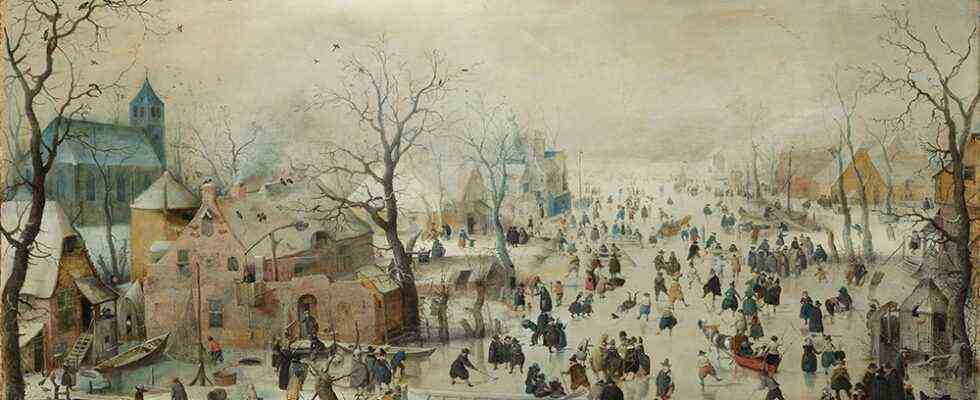Paradoxical climate effect: the “Little Ice Age”, which began around 1400, could have been triggered by an unusual heat surge in the North Atlantic, as climatologists have found out. The influx of warm water caused more icebergs to calve and weakened the North Atlantic overturning current. According to the scientists in the journal “Science Advances”, this initiated the cooling of the Little Ice Age within just 20 years.
Around 1400, an unusually cold climate phase began in Europe and North America. The Baltic Sea and many rivers froze over several times during this time, Alpine glaciers advanced into the valleys and the summers remained cool and rainy. In many places, the consequences were crop failures, famine and epidemics. But what triggered this cooling is still a matter of dispute. The causes are discussed Solar activity, increased volcanic eruptions, but also ocean currents or changes in vegetation.
Searching for clues in the North Atlantic
Now there are new indications of the causes of the unusual cooling a good 600 years ago. For their study, Francois Lapointe and Raymond Bradley from the University of Massachusetts investigated a number of traces that indicated momentous changes in the North Atlantic and the Arctic. “There is evidence that there was an increased transport of sea ice to the south during this period, which then led to the cooling of the North Atlantic,” they explain.
But why so many icebergs calved from the glaciers and sea ice surfaces and drifted south remained unclear. That is why Lapointe and Bradley used sediment drill cores from different areas of the North Atlantic and climate models to reconstruct what happened before this ice surge and what consequences it had.
Heat surge and strong circulating currents
The evaluations revealed: Before the cold of the Little Ice Age, there was a period of unusual warmth in the far north. Microfossils in the drill cores show that sea temperatures rose significantly to the south and west of Greenland, but also around Svalbard. This was caused by an unusually strong influx of warm water that peaked around 1380. “Nobody had recognized this peak before,” says Lapointe.

The driving force behind this influx of heat could have been a combination of two factors. Tree ring data indicate that there was a phase of increased solar activity at that time, which influenced the large-scale air circulation and led more high-pressure areas to Greenland and the far north. In addition, there was a particularly active phase of the North Atlantic overturning current (AMOC) – the “pump” that drives the Gulf Stream and other ocean currents in the Atlantic.
As the researchers found, there was simultaneous with the warming of the North Atlantic, a cooling along the US east coast and in the South Atlantic and increased rain in the tropics. “This is diagnostic of increased AMOC influence,” write Lapointe and Bradley. Because when the circulating current becomes stronger, it draws more warm water from the more southern climes. This then backs up in the North Atlantic and provides a warmth boost there.
Extreme flood of icebergs
But this warm phase ended abruptly: just 20 years later, temperatures in the North Atlantic fell and the circulating currents abruptly weakened, as the drill core data revealed. The reason for this: The increased influx of warm water encountered enormous ice masses that had accumulated in the Arctic in the decades before. Because several volcanic eruptions in the 13th century caused increased snowfall and the growth of glaciers and sea ice surfaces.
When masses of warm water poured north at the end of the 14th century, this triggered the great thaw. “The data indicate an extreme calving event around 1380, which could have been one of the most extreme in the last millennia,” the researchers report. As a result, icebergs drifted unusually far south and contributed to the cooling of the climate there.
At the same time, the increased influx of meltwater meant that the drive of the North Atlantic overturning current subsided. Much like it is today due to climate change is observed, as a result, less surface water sank into the depths and the “pump” sucked in less warm water from the south. This also weakened the ocean currents that transport heat to Europe and the east coast of North America.
First too warm, then too cold
According to the researchers, the Little Ice Age was ultimately a kind of backlash to a thermal anomaly immediately before it. Paradoxically, it was only the influx of heat into the north that caused the climate to change a little later. Once the cooling started, additional factors and feedback ensured that it stayed colder for several hundred years.
“In particular, a series of major volcanic eruptions that reduced solar radiation helped maintain this persistent cooling,” write Lapointe and Bradley. (Science Advances, 2021; doi: 10.1126 / sciadv.abi8230)
Source: University of Massachusetts Amherst

